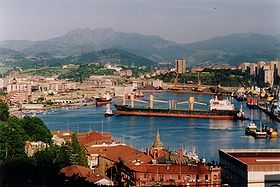
Pasaia
Encyclopedia

Municipality
A municipality is essentially an urban administrative division having corporate status and usually powers of self-government. It can also be used to mean the governing body of a municipality. A municipality is a general-purpose administrative subdivision, as opposed to a special-purpose district...
located in the province of Gipuzkoa in the Basque Autonomous Community
Basque Country (autonomous community)
The Basque Country is an autonomous community of northern Spain. It includes the Basque provinces of Álava, Biscay and Gipuzkoa, also called Historical Territories....
of northern Spain
Spain
Spain , officially the Kingdom of Spain languages]] under the European Charter for Regional or Minority Languages. In each of these, Spain's official name is as follows:;;;;;;), is a country and member state of the European Union located in southwestern Europe on the Iberian Peninsula...
. It is a fishing community, commercial port and the birth place of the fighting admiral Blas de Lezo
Blas de Lezo
Blas de Lezo y Olavarrieta , also known as "Patapalo" , and later as "Mediohombre" for the many wounds suffered in his long military life, was a Spanish admiral, and one of the greatest strategists and commanders in the history of the Spanish Navy...
. Pasaia lies approximately 5 km east of Donostia's centre, lying at the feet of Mount Ulia
Mount Ulia
Mount Ulia is a minor ridge located east of San Sebastián in the Basque Country, territory of Spain, reaching 243 m at its highest point. The ridge stretching out to the east along the coastline sinks in the strait leading to the Bay of Pasaia. The chain overlooks San Sebastian to the west, with...
and the Jaizkibel
Jaizkibel
Jaizkibel is mountain range of the Basque Country located east of Pasaia, north of Lezo and west of Hondarribia, in Spain, with 547 m at the highest point . The range stretches south-west to north-east, where it plunges into the sea at the Cape Higuer...
massif. The municipality
Municipality
A municipality is essentially an urban administrative division having corporate status and usually powers of self-government. It can also be used to mean the governing body of a municipality. A municipality is a general-purpose administrative subdivision, as opposed to a special-purpose district...
numbers 16,056 inhabitants (2008 estimates), clustering around the Bay of Pasaia in four nuclei, namely Pasai San Pedro, Pasai San Juan (or Donibane in Basque
Basque language
Basque is the ancestral language of the Basque people, who inhabit the Basque Country, a region spanning an area in northeastern Spain and southwestern France. It is spoken by 25.7% of Basques in all territories...
), Antxo and Trintxerpe, with each part showing distinctive features.
History
Pasaia is mentioned in documentary records for the first time in 1203 as Oiarso. The name of the village was later changed to "Pasage", which means 'port' in GasconGascon language
Gascon is usually considered as a dialect of Occitan, even though some specialists regularly consider it a separate language. Gascon is mostly spoken in Gascony and Béarn in southwestern France and in the Aran Valley of Spain...
. The Gascons
Gascony
Gascony is an area of southwest France that was part of the "Province of Guyenne and Gascony" prior to the French Revolution. The region is vaguely defined and the distinction between Guyenne and Gascony is unclear; sometimes they are considered to overlap, and sometimes Gascony is considered a...
had come to inhabit the area side by side with the Basque people at the beginning of the XIIIth century. The current name is first attested in the 15th century, when it was called the above "Pasage". In 1770 the district of Donibane received municipal rights from Charles IV of Spain
Charles IV of Spain
Charles IV was King of Spain from 14 December 1788 until his abdication on 19 March 1808.-Early life:...
.
Historically the area was controlled by two competing baronies, that of Hondarribia, who controlled the Donibane district, and Donostia, who controlled the San Pedro district. Donibane was detached from the Hondarribia barony in 1770, while San Pedro was separated from the Donostia barony in 1805. The Antxo district was formed in 1890, when the Irun-Madrid railway came through. Trintxerpe, next to San Pedro, was the last district to be formed. Trintxerpe and Antxo actually form a continuous urban strip with the eastern districts of the city of Donostia.
External links
- Official Website Information available in SpanishSpanish languageSpanish , also known as Castilian , is a Romance language in the Ibero-Romance group that evolved from several languages and dialects in central-northern Iberia around the 9th century and gradually spread with the expansion of the Kingdom of Castile into central and southern Iberia during the...
and BasqueBasque languageBasque is the ancestral language of the Basque people, who inhabit the Basque Country, a region spanning an area in northeastern Spain and southwestern France. It is spoken by 25.7% of Basques in all territories...
. - PASAIA in the Bernardo Estornés Lasa - Auñamendi Encyclopedia (Euskomedia Fundazioa) Information available in SpanishSpanish languageSpanish , also known as Castilian , is a Romance language in the Ibero-Romance group that evolved from several languages and dialects in central-northern Iberia around the 9th century and gradually spread with the expansion of the Kingdom of Castile into central and southern Iberia during the...

